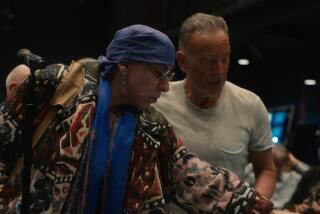Dual Career Tracks : A teacher by day and a bandleader by night, Bruce Lofgren concocts buoyant, fluid-lined works that draw on a multitude of styles.
- Share via
Bruce Lofgren, just like another Bruce--Bruce Wayne, whom we all know as Batman--leads an unusual dual existence: He’s an elementary school teacher by day, a guitarist, composer, arranger and bandleader by night.
Lucky fellow that he is, Lofgren, who fronts his big band, with guest singer Kathy Griggs, Monday at the Moonlight Tango Cafe in Sherman Oaks, is captivated by both sides of his life.
“I’m crazy about working with kids,” said Lofgren, 48, who has been teaching full time for the past four years, holds California certification as a bilingual teacher and is employed at Bushnell Way Elementary School in El Sereno. “Kids have a way of being honest even when they don’t want to be. They’re pure.”
Still, as much as Lofgren enjoys teaching, it’s in making music that he feels most alive. “If I have free time, I take out the guitar and start putting ideas down, sorting them out,” he said.
“It’s just a love, I guess,” he said in a telephone interview from the home in Alhambra that he shares with his wife, Raquel, and their three children.
Lofgren has found music to be a language that, unlike speech, allows him complete honesty and freedom. “In your interactions with people, you can’t always be as expressive as you want to be,” he said. “But in music, I can take ideas and see how they work together. It gives me an opportunity to tell a story in a way that listeners can’t always predict how it will come out, or, if they can, they can’t predict how they will get to that conclusion. That’s a joy.”
By no means a member of the mainstream, Lofgren instead concocts buoyant, fluid-lined works that draw on a multitude of styles, from jazz and rock to Latin, new age and classical. This approach makes sense when you learn that the musician, as a youth in his native Seattle, was first enthralled by the Beatles and Rolling Stones, and then, as he put it, “was totally sucked into the jazz world” at age 14.
“I don’t have any allegiance to any one idiom,” he said. “My idea is to use whatever tools I can to express a musical idea. Some of my pieces are through-composed, where there are no solos. I am not committed to the traditional jazz band direction. I don’t want to say, ‘This is a jazz band and we can’t do that.’ Which doesn’t mean I don’t like traditional jazz bands, such as Bill Holman or Bob Florence. It’s a joy to hear any kind of music that’s done well.”
Diane Varga, who produces the big-band events at the Moonlight Tango, said she found Lofgren’s music to be in that latter category. “A lot of people depart from the traditional and it’s not good,” she said. “But I feel Bruce has brought the music into a new place that’s challenging and interesting.”
Lofgren said a typical piece of his is “Parables,” which is in the unusual time meter of 7/8. “It starts out very intensely, with a lot of chordal movement,” he said. “Then it has a center section that gets very transparent, where there’s repeating thematic development that’s ultimately played by only a few instruments--light percussion and woodwinds. Then it builds from there to a boiling ending.”
Although he said he’s written nearly 700 big-band charts, some of which have been performed by such notables as Buddy Rich and Doc Severinsen, Lofgren keeps only about 50 numbers in his working repertoire. “If I took everything to a job, the scores would be too heavy to carry,” he joked. Most of these are newer works, because they reflect how far Lofgren feels he has evolved in his craft. But “new” does not always translate into original, he has discovered.
“You finish a score, it looks great, feels fresh,” he said. “But then after you play it 14 to 15 times, there are things that become hackneyed, that you can’t stand the sound of. That’s why artists have to re-edit their work. I have things from the ‘70s that I still play but not without a certain internal cringe, thinking what I’ve learned” since then.
One facet of his current output is its leanness, said Lofgren. “The idea is to do it better in less space, because the more you put in, the less you get out,” he said. “You get an idea, you think it’s great, there’s that soaring feeling of creativity. Then you have to come to the acid reality: Is this important or has it been done a hundred times?”
Though Manhattan Transfer-ite Janis Siegel appears on Lofgren’s 1986 Phoenix Records album, “Move Into Your Car,” he very rarely backs singers. And particularly not a blues-swing belter like Kathy Griggs, whose numbers will provide a startling contrast to his. “Her stuff is in quite a different direction than mine, more of a Count Basie concept,” he said. “But we did one rehearsal and it went fine.”
If there’s a downside to his current lifestyle, Lofgren said, it’s that he’s often short on sleep. “Many days I’ll go to bed at midnight or later, and get up at 6 a.m.,” he said. “Now, if I’ve played a gig, I’ll have a lot of adrenaline from that, but I can’t keep a schedule like that up for long.”
Where and When
Who: Bruce Lofgren’s big band, with singer Kathy Griggs.
Location: Moonlight Tango Cafe, 13730 Ventura Blvd., Sherman Oaks.
Hours: 7:30 p.m. and 9:30 p.m. Monday.
Price: Cover charge $13.
Call: (818) 788-2000.
More to Read
The biggest entertainment stories
Get our big stories about Hollywood, film, television, music, arts, culture and more right in your inbox as soon as they publish.
You may occasionally receive promotional content from the Los Angeles Times.








